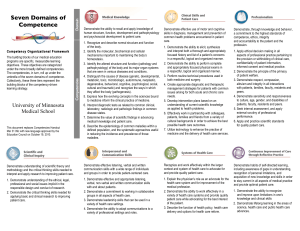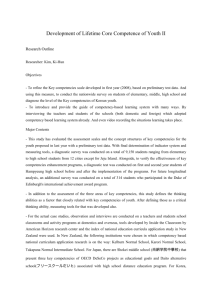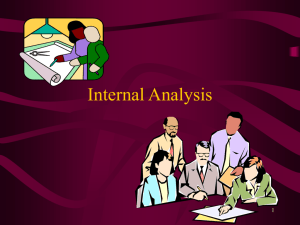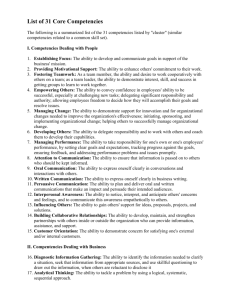SM-21
advertisement
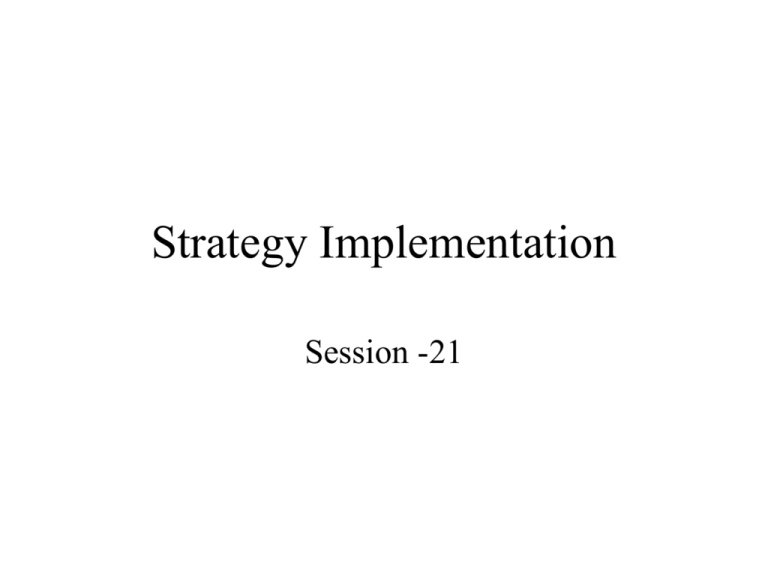
Strategy Implementation Session -21 Nuances of Strategy Implementation • Strategic Choice – Decision which selects from among the alternative grand strategies which will best meet the enterprises’ objectives. The choice involves consideration of selection factors, evaluation of the alternatives against these criteria and the actual choice Building an Organization Capable of Good Strategy Execution “The best game plan in the world never blocked or tackled anybody.” Vince Lombardi “A second-rate strategy perfectly executed will beat a first-rate strategy poorly executed every time.” Richard M. Kovacevich Chapter Roadmap • A Framework for Executing Strategy • The Principal Managerial Components of the Strategy Execution Process • Building an Organization Capable of Good Strategy Execution • Staffing the Organization • Building Core Competencies and Competitive Capabilities • Execution-Related Aspects of Organizing the Crafting vs. Executing Strategy Crafting the Strategy • Primarily a marketdriven activity • Successful strategy making depends on – Business vision – Perceptive analysis of market conditions and company capabilities – Attracting and pleasing customers – Outcompeting rivals Executing the Strategy • Primarily an operations-driven activity • Successful strategy execution depends on – Doing a good job of working through others – Good organizationbuilding – Building competitive capabilities Executing the Strategy • An action-oriented, make-things happen Implementation involves task involving management’s ability to . . . – Direct organizational change – Achieve continuous improvement in operations and business processes • Move toward operating excellence – Create and nurture a strategy-supportive culture – Consistently meet or beat performance targets Implementing a New Strategy Requires Adept Leadership • Implementing a new strategy takes adept leadership to – Convincingly communicate reasons for the new strategy – Overcome pockets of doubt – Secure commitment of concerned parties – Build consensus and enthusiasm Why Executing Strategy Is a Tough Management Job • Overcoming resistance to change • Wide array of demanding managerial activities to be performed • Numerous ways to tackle each activity • Number of bedeviling issues to be worked out • Demands good people management skills • Requires launching and managing Who Are the Strategy Implementers? • Implementing and executing strategy involves a company’s whole management team and all employees – Just as every part of a watch plays a role in making the watch function properly, it takes all pieces of an organization working cohesively for a strategy to be well-executed • Top-level managers must lead the process and orchestrate major initiatives Goals of the Strategy Process •Implementing-Executing Unite total organization behind strategy • See that activities are done in a manner that is conducive to first-rate strategy execution • Generate commitment so an enthusiastic crusade emerges to carry out strategy • Fit how organization conducts its operations to strategy requirements Characteristics of the Strategy Implementation Process • Every manager has an active role • No proven “formula” for implementing particular types of strategies • There are guidelines, but no absolute rules and “must do it this way” rules • Many ways to proceed that are capable of working Characteristics of the Strategy Implementation Process (continued) • Each implementation situation occurs in a different context, affected by differing – Business practices and competitive situations – Work environments and cultures – Policies – Compensation incentives – Mix of personalities and firm histories • Approach to implementation/execution Fig. 11.1: The Eight Components of the Strategy Execution Process What Top Executives Have to Do in Leading the Implementation • Communicate theProcess case for change • Build consensus on how to proceed • Arouse enthusiasm for the strategy to turn implementation process into a companywide crusade • Empower subordinates to keep process moving • Establish measures of progress and deadlines • Reward those who achieve implementation milestones Test Your Knowledge Management's handling of the strategy implementation/execution process can be considered successful A. so long as a company is profitable. B. if and when the company meets or beats its performance targets and shows good progress in achieving its strategic vision for the company. C. once the company's management team convinces a majority of company personnel that the company is headed in the right direction. D. if management is able to put the strategy in place BUILDING A CAPABLE ORGANIZATION — WHAT IS INVOLVED? Fig. 11.2: The Three Components of Building an Organization Capable of Proficient Strategy Execution Putting Together a Strong Management Team • Assembling a capable management team is a cornerstone of the organization-building task • Find the right people to fill each slot – Existing management team may be suitable – Core executive group may need strengthening Selecting the Management Team: Key Considerations • Determine mix of – Backgrounds – Experiences and know-how – Beliefs and values – Styles of managing and personalities • Personal chemistry must be right • Talent base needs to be appropriate Recruiting and Retaining Talented Employees: Implementation Issues • The quality of a company’s people is an essential ingredient of successful strategy execution • Biggest challenge facing companies – How to recruit and retain the best and brightest talent with strong skill sets and management potential • Intellectual capital, not tangible assets, is increasingly being viewed as the most Key Human Resource Practices to Attract and Retain Talented Employees • Spend considerable effort in screening job applicants, selecting only those with – Suitable skill sets – Energy and initiative – Judgment and aptitudes for learning – Ability to adapt to firm’s work environment and culture • Put employees through training programs throughout their careers Key Human Resource Practices to Attract and Retain Talented Employees (continued) • Rotate employees through jobs with great content, spanning functional and geographic boundaries • Encourage employees to – Be creative and innovative – Challenge existing ways of doing things and offer better ways – Submit ideas for new products or businesses • Foster a stimulating work environment Building Core Competencies and Competitive Capabilities • Crafting the strategy involves – Identifying the desired competencies and capabilities to build into the strategy to help achieve a competitive advantage • Good strategy execution requires – Putting desired competencies and capabilities in place, – Upgrading them as needed, and Example: Intel’s Core Competence Design and mass production of complex chips for personal computers Example: Procter & Gamble’s Core Competencies Superb marketing-distribution skills and R&D capabilities in five core technologies - fats, oils, skin chemistry, surfactants, emulsifiers Example: General Electric’s Core Competencies Developing professional managers with broad problem-solving skills and proven ability to grow global businesses Example: Disney’s Core Competencies Theme park operation and family entertainment Example: Dell’s Core Competencies Capabilities to deliver state-of-the-art products to customers within days of nextgeneration components coming available and at attractively low costs Example: Toyota’s Core Competence Legendary “production system” giving it the capability to produce high-quality vehicles at relatively low costs Three-Stage Process of Developing Competencies and Capabilities 1. Develop ability to do something 2. As experience builds, ability can translate into a competence or capability 3. If ability continues to be polished and refined, it can become a distinctive • Step 1 in Developing Competencies Develop ability to do something – Select people with relevant skills/experience – Broaden or expand individual abilities as needed – Mold efforts and work products of individuals into a cooperative effort to create organizational ability Step 2 in Developing Competencies • As experience builds and company learns how to perform the activity consistently well and at acceptable cost, the ability evolves into a competence or capability • Typically, a capability or competence emerges from establishing and nurturing collaborative relationships between – Individuals and groups in different departments and/or – A company and its external allies Step 3 in Developing Competencies • If company masters the activity, performing it better than rivals, the “capability” or “competence” becomes a – Distinctive competence and – Holds potential for This competitive is the optimal outcome of the process advantage of building capabilities-competencies! Managing the Process of Building Competences: Four Key Traits 1. Competencies are bundles of skills and knowhow growing from combined efforts of crossfunctional departments 2. Normally, competencies emerge incrementally from various company efforts to respond to market conditions 3. Leveraging competencies into competitive advantage requires concentrating more effort and talent than rivals on strengthening competencies to create valuable capabilities Approaches to Developing Competencies • Internal development involves either – Strengthening the company’s base of skills, knowledge, and intellect or – Coordinating and networking the efforts of various work groups and departments • Partnering with key suppliers, forming strategic alliances, or maybe even outsourcing certain activities to specialists Updating Competencies and Capabilities as Conditions Change • Competencies and capabilities must continuously be modified and perhaps even replaced with new ones due to – New strategic requirements – Evolving market conditions – Changing customer expectations • Ongoing efforts to keep core competencies up-to-date can provide a basis for sustaining both Strategic Role of Employee Training • Training plays a critical role in implementation when a firm shifts to a strategy requiring different – Skills or core competences – Competitive capabilities – Managerial approaches – Operating methods • Types of training approaches – Internal “universities” Competitive Advantage Potential of Competencies and When it is difficult to outstrategize rivals Capabilities with a superior strategy . . . . . . Best avenue to industry leadership is to out-compete rivals with superior strategy execution! Building competencies and capabilities rivals can’t match is one of the best ways to out-compete them! Test Your Knowledge When it is difficult or impossible to out-strategize rivals (beat them with a superior strategy), the other main avenue to competitive advantage is to A. institute a lower cost organization structure. B. outcompete them with smarter managers. C. do a better job of selecting and training employees. D. outexecute them (beat them by performing certain Execution-Related Aspects of Organizing Work Efforts • Few hard and fast rules for organizing – One Big Rule: Role and purpose of organization structure is to support and facilitate good strategy execution! • Each firm’s structure is idiosyncratic, reflecting – Prior arrangements and internal politics CEO – Executive judgments and preferences about how to arrange reporting relationships Vice President Vice President Vice President – How best to integrate and coordinate work Fig. 11.3: Structuring the Work Effort to Promote Successful Strategy Execution Step 1: Decide Which Value Chain Activities to Perform Internally and Which to Outsource • Involves deciding which activities are essential to strategic success – Most strategies entail certain crucial business processes or activities that must be performed exceedingly well or in closely coordinated Critical activities fashion if the strategy is to be executed with real proficiency • These processes/activities usually need to be performed internally Determining Strategy-Critical Activities: Issues ortobusiness Consider 1. What functions processes have to be performed extra well or in timely fashion to achieve competitive advantage? 2. In what value-chain activities would poor execution seriously impair strategic success? Potential Advantages of Outsourcing Non-Critical Activities • A company improves its chances for outclassing rivals in – Performing strategy-critical activities and – Turning a core competence into a distinctive competence • Streamlining of internal operations that flows from outsourcing acts to – Decrease internal bureaucracies – Flatten organization structure – Speed decision-making Appeal of Outsourcing • Outsourcing non-critical activities allows a firm to concentrate its energies and resources on those value-chain activities where it – Can create unique value – Can be best in the industry – Needs direct control to Potential Advantages of Partnering • By building, improving, and then leveraging partnerships, a firm enhances its overall capabilities and builds resource strengths that – Deliver value to customers – Rivals can’t quite match Partnering makes strategic sense when the result is to pave enhance a company’s – Consequently the way competencies and competitive capabilities. for competitive success Dangers of Outsourcing • A company must guard against hollowing out its knowledge base and capabilities • Way to guard against pitfalls of outsourcing – Avoid sourcing key components from a single supplier – Use two or three suppliers to minimize dependence on any one supplier For Discussion: Your Opinion While many people have criticized companies that have outsourced functions once performed in-house to foreign suppliers (who can perform the functions more cheaply) because outsourcing results in involuntary layoffs or job cuts, it is really fairer and more accurate to view outsourcing as a means whereby a company can enhance its Step 2: Make Strategy-Critical Activities the Main Building Blocks • Assign managers of strategy-critical activities a visible, influential position • Avoid fragmenting responsibilityAssign for managers strategy-critical activities across keymany roles departments Support Primary activities Strategic • Provide coordinating linkages relationships between related work groups functions Coordination Valuable capability What Types of Organizational Structures Fit Which Strategies? • A company operating in one business – Functional department structure • A company with operations in various parts of the world – Geographic organizational units • A vertically integrated company – Divisional organizational structure • A diversified company Step 3: Determine How Much Authority to Delegate to Whom • In a centralized structure – Top managers retain authority for most decisions • In a decentralized structure – Managers and employees are empowered to make decisions • Trend in most companies Characteristics of Centralized Decision Making • Top executives retain authority – For most strategic and operating decisions and – Keep a tight rein on lower-level managers • Minimal discretionary authority is granted to – Frontline supervisors – Rank-and-file employees • Key advantage – Tight control by top managers fixes accountability • Disadvantages – Lengthens response time to changing conditions – Does not encourage responsibility among lower-level Advantages of a Decentralized Structure • Creates a more horizontal structure with fewer management layers • Managers and employees develop their own answers and action plans – Make decisions in their areas of responsibility – Held accountable for results • Shortens organizational response times and spurs – New ideas – Creative thinking and innovation – Greater involvement of managers and employees • Jobs can be defined more broadly Maintaining Control in a Decentralized Structure • Place limits on authority empowered employees can exercise • Hold people accountable for their decisions • Institute compensation incentives that reward employees for doing their jobs in a manner contributing to good company performance For Discussion: Your Opinion A decentralized organization structure is more likely to further the cause of good strategy execution than is a centralized organization structure. True or false? Explain. Step 4: Provide for Internal Cross-Unit Coordination • Classic method of coordinating activities – Have related units report to single manager – Upper-level managers have clout to coordinate efforts of their units • Support activities should be woven into structure to – Maximize performance of primary activities Guard Against Functional Designs That Fragment Activities • Scattering pieces of critical business processes across several specialized departments results in – Many hand-offs which • Lengthens completion time • Drives up administrative costs • Increases risk of details falling through the cracks – Obsession with activity rather than result • Solution Business process Examples of Fragmented Strategy-Critical Activities • Filling customer orders • Speeding new products to market • Improving product quality • Supply chain management • Building capability to conduct business via the Internet Coordinating Mechanisms to Supplement the Basic Organization Structure • Cross-functional task forces • Dual reporting relationships • Informal networking • Voluntary cooperation • Incentive compensation tied to group performance Step 5: Provide for Collaboration With Outsiders • Need multiple ties at multiple levels to ensure – Communication – Coordination and control • Find ways to produce collaborative efforts to enhance firm’s capabilities and resource strengths • While collaborative relationships present Roles of Relationship Managers With Strategic Partners • Get right people together • Promote good rapport • See plans for specific activities are developed and implemented • Help adjust internal procedures and communication systems to – Iron out operating dissimilarities Test Your Knowledge Which one of the following tends to be most important in building an organization capable of good strategy execution? A. Selecting a capable management team and selecting and training employees B. Building and strengthening competencies and competitive capabilities C. Empowering employees and utilizing the advantages of decentralized decision-making D. Making strategy-critical activities the main building blocks in the organizational scheme Current Organizational Trends • Numerous companies have completed the task of remodeling traditional, hierarchical structures built on – Functional specialization and – Centralized authority • Corporate downsizing movement in the late 1980s and early 1990s was aimed at – Recasting authoritarian, pyramidal Drawbacks of Centralized Authoritarian Structures • Centralized or authoritarian structures have often turned out to be a liability where – Customer preferences shift from standardized to customized products – Product life-cycles grow shorter – Flexible manufacturing replaces mass production – Customers want to be treated as individuals Organizational Structures of the Future: Overall Themes • Revolutionary changes in how work is organized have been triggered by – New strategic priorities – Rapidly shifting competitive conditions The future structure will be . . . • Tools of organizational design include – Empowered managers and workers – Reengineered work processes – Self-directed work teams – Rapid incorporation of Internet Characteristics of Organizations of the Future • Extensive use of Internet technology and e-commerce business practices Change & Learning • Fewer barriers between – Different vertical ranks – Functions and disciplines – Units in different geographic locations – Company and its suppliers, distributors, strategic allies, and customers • Capacity for change and rapid learning


